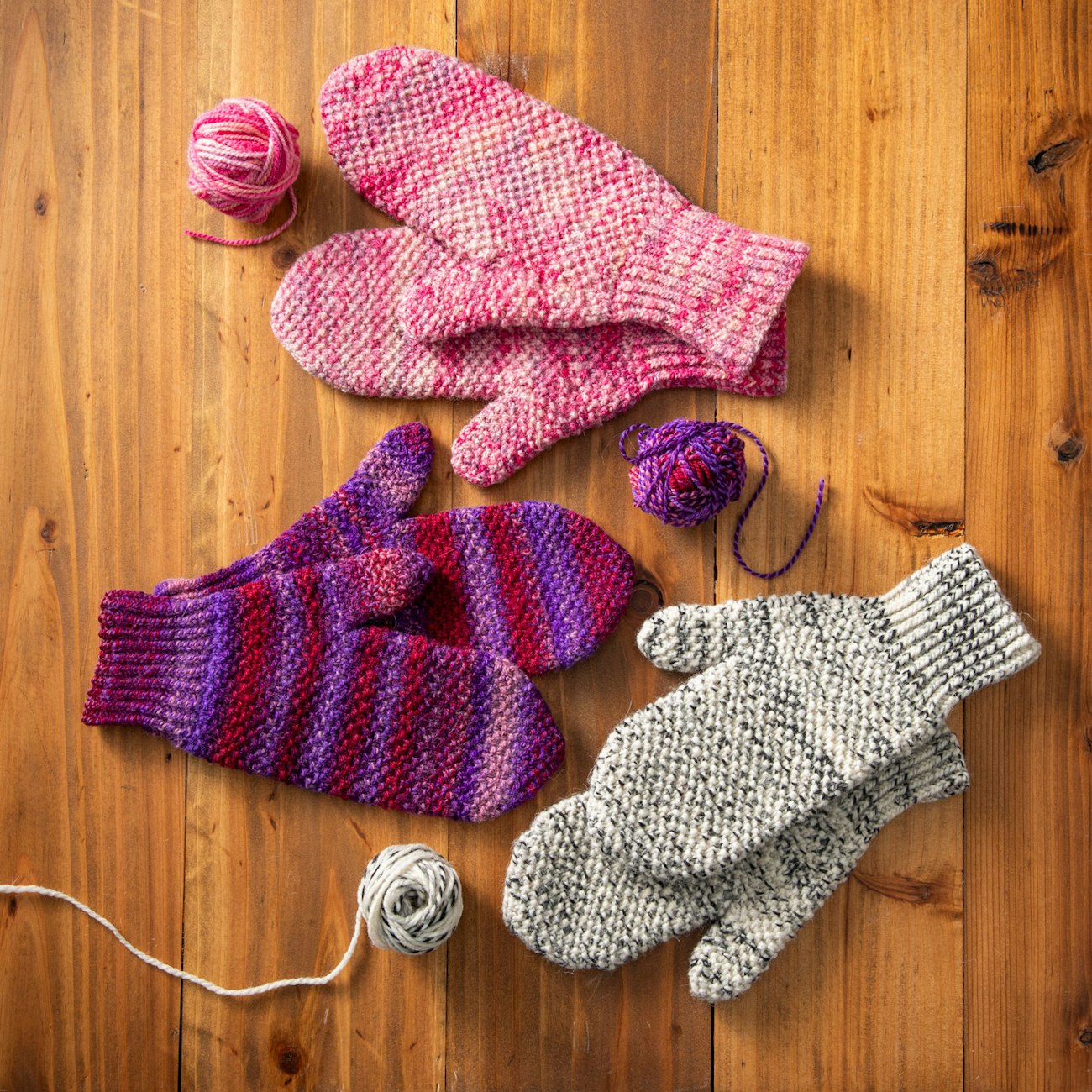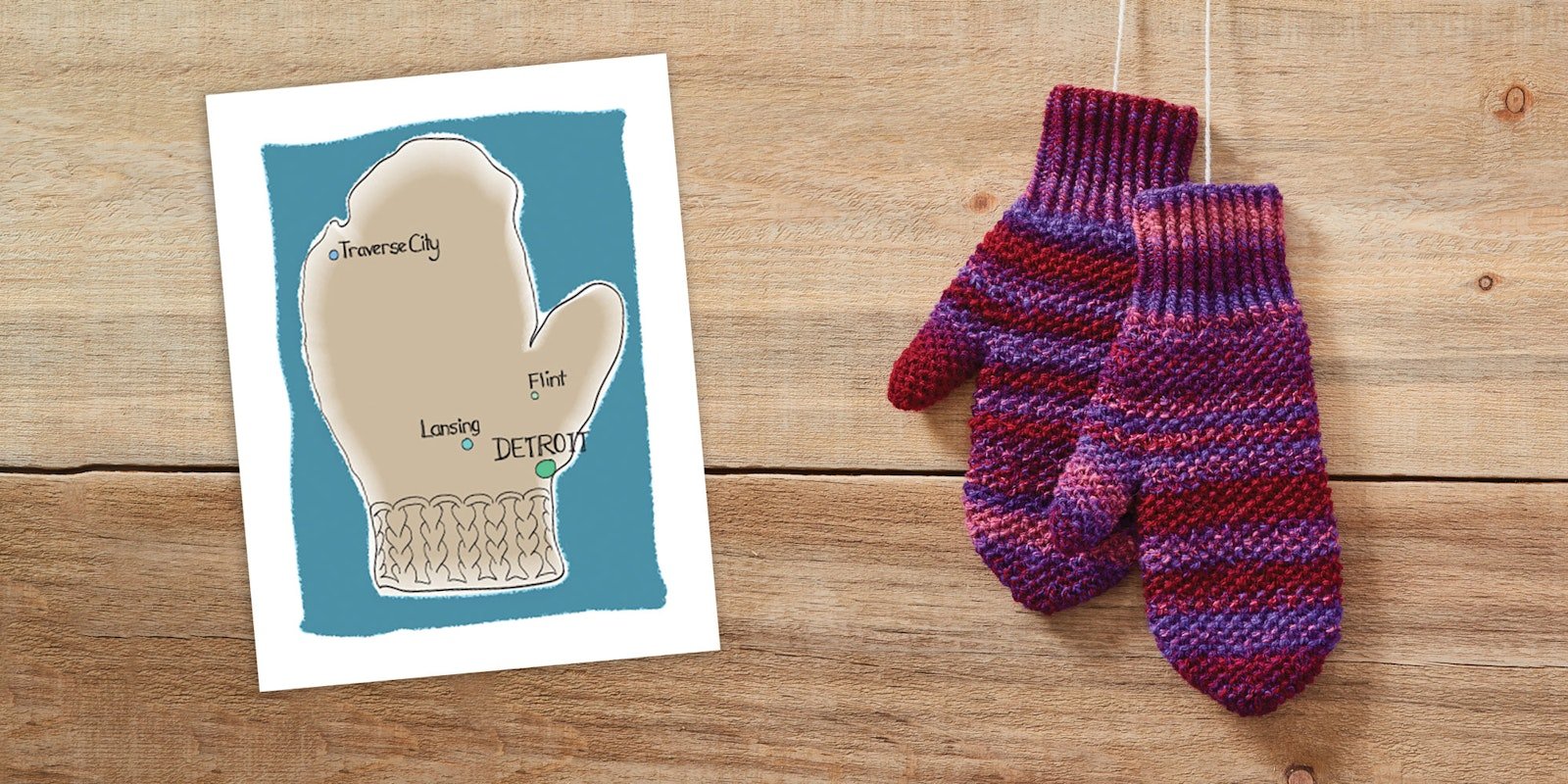The Lower Peninsula of Michigan is in the shape of a mitten, and that’s the reason Michigan is referred to as “the Mitten State.” I live in the northwest corner of the Lower Peninsula. Winters are long here; it can start snowing in October with snowfall sometimes continuing throughout April. Mittens, therefore, are essential winter wear.
Most important to me, mittens must be warm. To accomplish the needed warmth, I chose a slip-stitch pattern. I have always been fascinated by slip-stitch patterns; they produce amazing textures and can result is surprising color effects. Many years ago, I designed and knitted a jacket using several slip-stitch patterns. While designing, I must have swatched 20 to 30 different stitch patterns. On one pattern that pleased me, but was not going to work for the jacket, I wrote myself a note: “This would be a good stitch pattern for mittens.”
It is the Nubbly Tweed pattern, and it is good for mittens. At first glance, this pattern looks like a simple seed stitch. But it is so much more! Slipping stitches as specified results in what is essentially a thick two-layer fabric, with the inside layer smooth (a nice feeling against the hands) and the outside layer “nubbly.”

Amy's three pairs of Mittens from the Mitten State: from top, the original sturdy handspun Île de France pair; a handspun Montadale pair; and a soft, dressy pair. Photo by Matt Graves
I’ve knitted three pairs of these mittens for myself. My first pair was from yarn that I spun from wool of an Île-de-France sheep. This breed is better known for its meat and milk than its wool, but I really like the wool: not only is it durable, but it’s also very springy. Anything knitted from this wool really hugs the wearer. I find that to be so cozy, just right for winter. I’ve worn these mittens for a decade now, shoveling snow and walking my dog on a leash. I rarely find any pilling despite all the abuse I apply to them.
The second pair I knitted is the pair shown with the pattern. I spun the yarn from wool from Montadale sheep. This sheep breed is considered “dual purpose,” raised for its meat and its wool. Montadale wool is a bit softer than Île-de-France, but I would not consider it next-to-skin soft. It is also fantastically durable. This pair I knitted in 2017, and I also them as work mittens. They have held up very well . . . except for the time my dog chewed the thumb off of one of the mittens. I used some of the leftover yarn to reknit the thumb. I love these mittens—and my dog!
The third pair, I knitted just last year. Instead of work mittens, I consider this pair to be “fashion” mittens. I wear them when I go into town and want to look a bit fancier than my usual backwoods bohemian self. I used a softer yarn, Pirate Sheep DK Yarn by Treasure Goddess Yarn. It’s 100% Peruvian highlands wool, and it’s considered a DK-weight yarn. I love the softness of these mittens, so I pamper them; I would never shovel snow or walk the dog with these lovelies.
If you are interested in breed-specific wool yarns, I suggest you visit a local fiber festival. If that is not feasible, there are now some good online sources that are known for multiple breed-specific yarns, as well as blends of specified breeds. Here are some:
• Bare Naked Wools
• The Ross Farm
• Solitude Wool
• Why Knot Fibers
Resources
Adair, Cass. “When Did We Start Calling Michigan ‘the Mitten State?’” Stateside, Michigan Radio, Ann Arbor, Michigan, December 17, 2015.
Budd, Ann. The Knitter’s Handy Book of Patterns. Loveland, Colorado: Interweave, 2002.
Montadale fiber from Frivolous Ewe
Pirate Sheep DK Yarn by Treasure Goddess Yarn
The Harmony Guides: 440 More Knitting Stitches, Volume 3. London: Collins & Brown Limited, 1998.
MATERIALS AND PATTERN
Yarn 200 (250) yd DK-weight (or Craft Yarn Council weight #3 Light). See Notes.
Needles Size 4 (3.5 mm): set of double-pointed (dpn). Adjust needle size if necessary to obtain the correct gauge.
Notions Markers (m); stitch holder; tapestry needle.
Gauge 24 sts and 60 rnds = 4" in nubbly tweed patt.
Finished size 7¼ (8)" hand circumference and 9¾ (10¾ )" tall; to fit a woman's medium (man's medium). Mittens shown measure 7¼".
Visit farmfiberknits.com/abbreviations for terms you don’t know.
View and print this pattern as a PDF here: Mittens from the Mitten State
Notes
• These mittens are worked in the round from the cuff up.
• Increase rounds for thumb gusset are worked as follows: work in pattern to marker, slip marker, M1 (see next note) in pattern, work in pattern to next marker, M1 in pattern, slip marker, work in pattern to end—2 sts increased.
• On increase rounds, if the stitch following the first marker is a knit stitch, M1P before this stitch; if the stitch following the first marker is a purl stitch, M1 before this stitch.
• On increase rounds, if the stitch in front of the second marker is a knit stitch, M1P after this stitch; if the stitch in front of the second marker is a purl stitch, M1 after this stitch.
• As stitches are added to the thumb gusset, the stitch immediately prior to and immediately after the markers will sometimes be the same.
• For top of hand and top of thumb, work decreases as k2tog or p2tog as needed to remain in pattern.
Amy Tyler has had life-long ties to northern Michigan, and she values every single day of this region’s winter wonderland. She is grateful to spin and knit in this beautiful place. You can find out more about her fiber work and teaching on her website, stonesockfibers.com.

